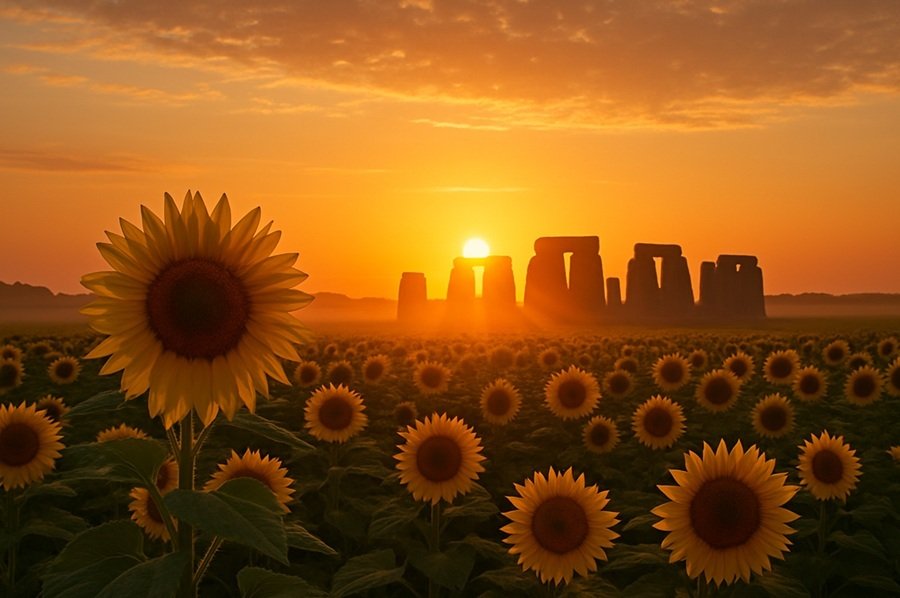
Introduction
The Summer Solstice, also known as Midsummer, marks the longest day and shortest night of the year. In 2025, it will occur on Saturday, June 21, with the solstice moment happening at 08:11 AM (local time). On this day, the Sun rises at 05:15 AM and sets at 07:10 PM, creating a day length of approximately 13 hours, 54 minutes, and 39 seconds.
This celestial event not only heralds the official start of summer in the Northern Hemisphere but also holds deep cultural, spiritual, and agricultural significance across civilizations.
What is the Summer Solstice?
The Summer Solstice occurs when the Earth’s axial tilt is most inclined toward the Sun, resulting in the Sun reaching its highest position in the sky at noon. This causes the longest duration of daylight during the entire year.
- In the Northern Hemisphere, this marks the beginning of astronomical summer.
- It is the day when the North Pole is tilted closest to the Sun.
- Conversely, in the Southern Hemisphere, it marks the Winter Solstice, or the shortest day of the year.
Astronomical Details for June 21, 2025
| Event | Time / Duration |
|---|---|
| Summer Solstice Moment | 08:11 AM |
| Sunrise | 05:15 AM |
| Sunset | 07:10 PM |
| Day Duration | 13h 54m 39s |
| Previous Day Duration | 13h 54m 38s |
| Next Day Duration | 13h 54m 37s |
As evident, June 21, 2025, will witness the peak of daylight with a fractionally longer day than those adjacent to it.
Why Is the Solstice Important?
The solstice is not just a scientific event—it has deep-rooted importance in:
1. Agriculture
- Ancient farmers used solstices to time their planting and harvesting cycles.
- It marked the peak of crop-growing sunlight hours.
2. Spirituality
- Many ancient cultures believed this day represented life, light, and abundance.
- It’s a day to celebrate nature, fertility, and renewal.
3. Calendar Systems
- Ancient civilizations, including the Maya, Egyptians, and Druids, created calendars and built monuments aligned with the solstice (e.g., Stonehenge).
🕯️ Spiritual and Cultural Significance
🌄 Stonehenge (UK)
Thousands of people gather to watch the Sun rise over the Heel Stone—an event aligned with the summer solstice since prehistoric times.
🔥 Midsummer Celebrations (Scandinavia)
In Sweden, Norway, and Finland, bonfires, floral crowns, music, and dance fill the night in honor of Midsummer’s spiritual essence.
🌻 Native American Traditions
Tribes such as the Lakota and Hopi celebrate with ceremonial dances and prayers to honor the Earth and the Sun’s power.
🛕 Indian Context
In India, though the solstice isn’t traditionally marked with fanfare, the Sun (Surya) is worshipped through rituals like Surya Namaskar, and International Yoga Day is observed around this date globally.
International Yoga Day: A Solstice Celebration
The United Nations declared June 21 as International Yoga Day in 2015, chosen for its alignment with the Summer Solstice. Yoga, a discipline of inner balance and alignment with nature, perfectly resonates with the spiritual energy of the solstice.
Practicing yoga on this day symbolizes:
- Harmony between body and nature
- Awakening of consciousness
- Celebration of vitality and light
Summer Solstice Rituals and Customs
Across the world, people perform different rituals to celebrate the Solstice:
🔥 Light a Bonfire
Represents the Sun’s strength and protection against negative energy.
🌸 Create a Flower Crown
In European traditions, wearing a flower crown honors fertility and the Earth’s beauty.
🧘 Perform Sun Salutations
An ideal way to align the body with the rising energy of the Sun.
✨ Reflect and Set Intentions
The solstice is a powerful time to set goals, initiate positive changes, and express gratitude for growth.
Scientific and Seasonal Impacts
- Higher UV Index: With the Sun at its peak, UV levels are highest—sunscreen is essential.
- Longest Shadows at Sunrise & Sunset: Because the Sun’s path is longest.
- Delayed Sunset: Creates a longer evening—perfect for outdoor activities.
- High Solar Power Generation: Ideal for solar energy capture and sustainability efforts.
Solstice vs Equinox: What’s the Difference?
| Feature | Solstice | Equinox |
|---|---|---|
| Meaning | “Sun stands still” | “Equal night” |
| Day/Night Length | Longest or shortest | Nearly equal |
| Dates | June 21 & Dec 21 | March 21 & Sept 23 |
| Sun’s Position | Most tilted toward/away | Directly above the equator |
How Different Cultures View the Solstice
| Region | Custom |
|---|---|
| China | Yin energy is celebrated as yang reaches its peak. |
| Greece | Associated with Kronia, a time of role reversal. |
| Andean Cultures | Celebrate Inti Raymi, the festival of the Sun. |
| Japan | Engage in seasonal foods and nature-focused rituals. |
Tips to Celebrate the Summer Solstice 2025
- Wake up early to watch the sunrise – especially at 05:15 AM!
- Spend the day outdoors – go hiking, swimming, or simply sunbathe.
- Join a yoga session – celebrate Yoga Day in nature.
- Journal your intentions – a spiritual reset aligned with celestial timing.
- Create art or music inspired by the Sun – express creativity.
Fun Facts About the Summer Solstice
- Earth is actually farthest from the Sun during the Northern Hemisphere’s summer solstice (aphelion).
- The word “solstice” comes from Latin solstitium, meaning “Sun stands still.”
- At the Arctic Circle, the Sun never sets—creating the Midnight Sun phenomenon.
📌 Conclusion
The Summer Solstice on Saturday, June 21, 2025, is more than just an astronomical event—it’s a celebration of light, nature, energy, and life. With 13 hours, 54 minutes, and 39 seconds of daylight, it’s the perfect opportunity to reflect, realign, and reconnect with the universe’s natural rhythm.
Whether you greet the sunrise with yoga, dance under the sunset sky, or simply bask in the warmth of the day, let this solstice fill your spirit with light and renewal.







